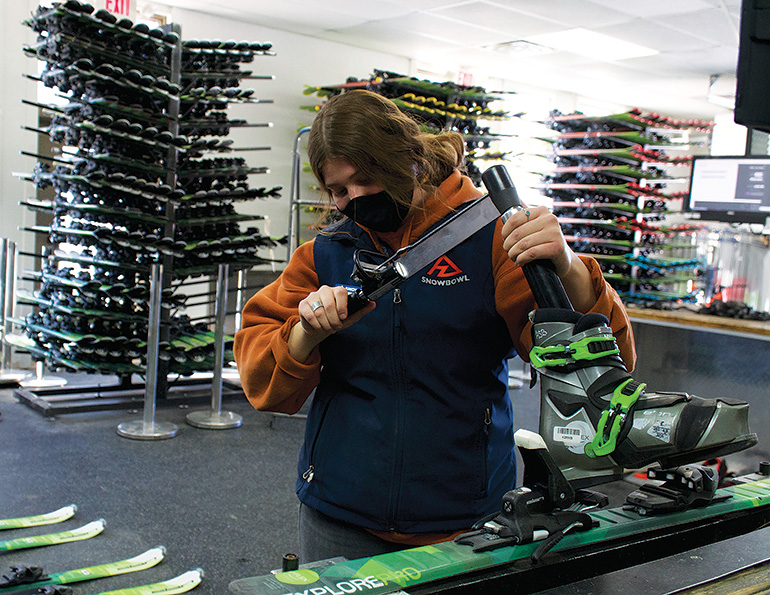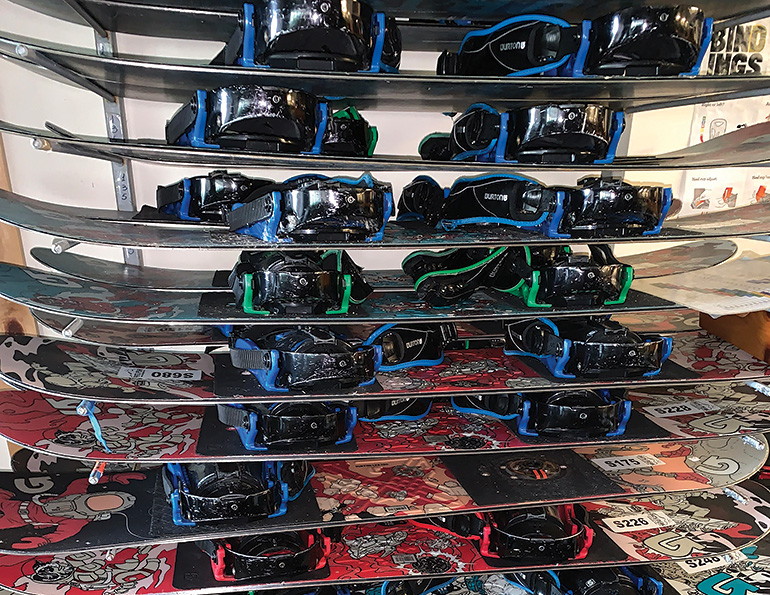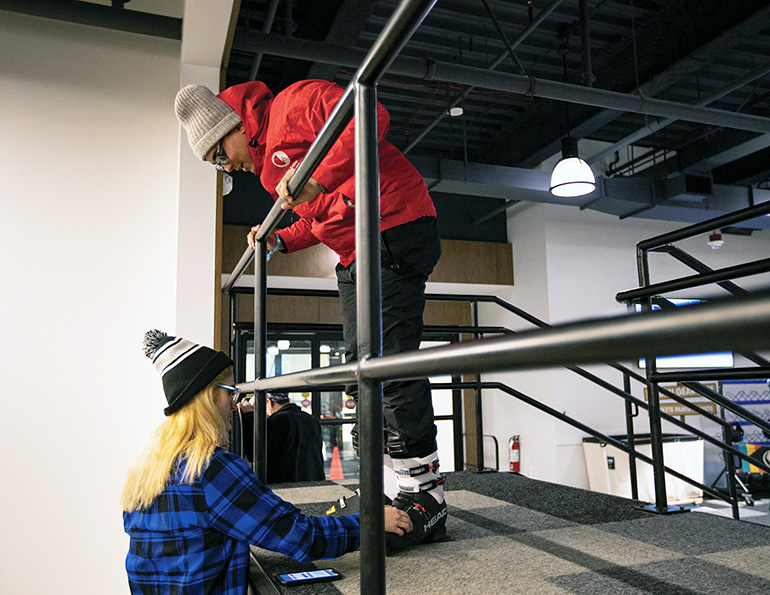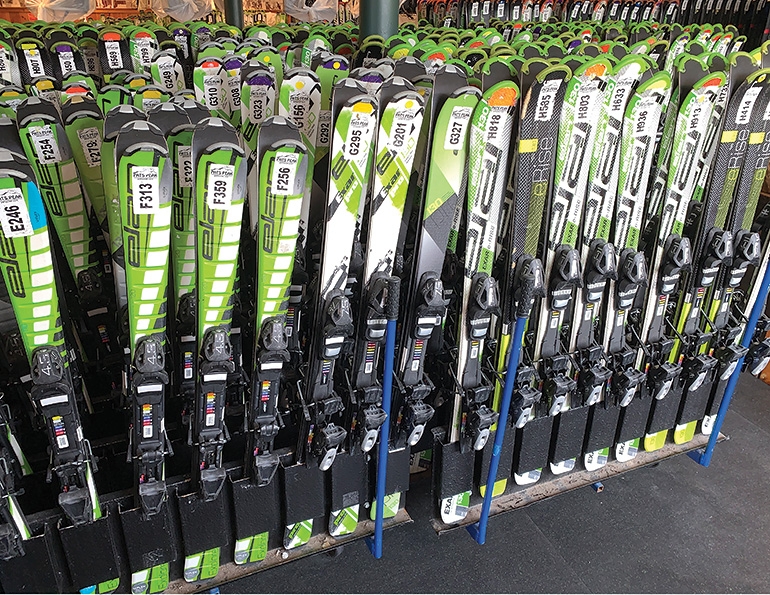In a skier’s journey from the parking lot to the slopes, the rental process has often been a mud bog along the way. Over the years, customer service innovations have gone far to facilitate and expedite the lot-to-lift trip: ambassadors to orient arriving skiers, multi-day tickets to reduce lines at the ticket windows, high-speed, high-capacity lifts to pare lift lines to a minimum, and so on. But renting gear often remained cumbersome, sluggish, and confusing, especially for the uninitiated novices who represent the great majority of renters.
All it took was a good, old-fashioned pandemic to jumpstart a new way of thinking about how to make the rental process speedier and more customer-friendly. Covid-19 restrictions, especially social distancing and limited indoor activity, forced rental shop managers to rethink the rental process from top to bottom.
Among the pandemic-induced changes: a shift to online rental transactions, and at least a partial move to completing the fitting process outside. These will be lasting components of the rental process in a post-pandemic world, according to several ski-area personnel. “Seventy-five percent of the Covid changes are not going away,” says Rick Schmitz, owner of three Wisconsin ski areas.
The reason? The changes worked. Here's a look at how the successful innovations have altered the rental game.
NO. 1: ADVANCE RESERVATIONS
Pre-arrival rental reservations aren’t new, of course. Many resorts already had a reservation system in place pre-pandemic. But for the most part, online reservations represented only a tiny fraction of the overall rental business. That fraction grew last winter. Even those areas that had pushed many renters into advanced reservations saw an increase in online bookings.
The goal: 100 percent online bookings. According to Carolyn Stimpson, VP of mountain services at Wachusett Mountain, Mass., (which, given its proximity to metro Boston, can process as many as 5,000 rentals in a day, representing 58 percent of resort guests), advance reservations once accounted for roughly 40 percent of the rental total. In 2020-21, that number jumped to 95 percent, according to Stimpson, hitting the 100-percent mark on some days.
Schmitz says his resorts are already there, going to 100 percent online sales for both lift tickets and rentals.
Ryan Hartl, resort services director at Arizona Snowbowl, sees rental reservations nearing 100 percent in the future; just five years ago, Snowbowl’s reservation business was at absolute zero. The change from in-person to online transactions was already underway before 2020-21, but the arrival of Covid put a heavy foot on the accelerator.
 Rental reservations at Arizona Snowbowl went from zero to, hopefully, 100 percent in the near future. Last season, advance reservations allowed techs to pre-set rental equipment, helping to streamline the process.
Rental reservations at Arizona Snowbowl went from zero to, hopefully, 100 percent in the near future. Last season, advance reservations allowed techs to pre-set rental equipment, helping to streamline the process.
And that was the norm nationwide. “Covid has propelled us forward 20 years,” says Eric Lipton, chief operating officer of SNOW Operating, which works with 55 resorts worldwide.
Some areas, spurred by the social-distancing need to limit indoor numbers at any particular time, segmented rental time slots, with renters booking equipment for a period of four to six hours instead of a full day. This spread-out business more efficiently and minimized the morning rush hour.
Predictability leads to efficiencies. A big advantage of the move toward all-reservation rental business has been predictability—knowing ahead of time how busy the rental arena will be and when. That has enabled efficiencies in both staffing management and inventory management. “You know if you might be short-staffed or over-staffed or where to assign people,” says Arizona Snowbowl rental and retail manager Elise Dobberman. Lipton agrees, saying that a reservation system yields “better forecasting and better planning—better inventory management and better staffing.”
One potential downside of online reservations—the headaches caused by errors in the sizing information provided by skiers and riders—has proved to be relatively minor, says Lipton. His observation at the resorts he has worked with is that “pre-teching,” binding settings in particular, has been successful 80 to 85 percent of the time. Stimpson says that, with Head’s BYS system in play at Wachusett, any setting adjustments are quick and minimal.
Without a system like BYS, however, pre-setting equipment might make less sense. Due to the use of adjustable bindings at his resorts, Schmitz says, “pre-setting doesn’t work for us.”
NO. 2: SPREADING OUT
If online reservations are the biggest takeaway in rental changes from 2020-21, not far behind is the move to spread things out, specifically moving much of the fitting process outdoors. Wachusett built a deck with radiant heat and a tent for that purpose. Rental skis were moved outdoors on movable racks for the day and back inside for overnight storage. Arizona Snowbowl separated its boot-fitting and ski- or snowboard-fitting areas by moving the latter into an open garage space. Other resorts employed similar strategies.
The result: improved throughput. Hartl notes that Snowbowl saw a 25 percent increase in throughput. Stimpson estimates that the shift to outdoor rental fitting at Wachusett has cut roughly a minute off the typical time it takes a resort guest to go through the rental process. If you happen to be fitting 5,000 rentals in a day, one minute per customer adds up quickly.
Consequently, those interviewed by SAM agreed that the indoor-outdoor arrangement, or a variation of it, is here to stay.
That suggests, of course, that many resorts had previously been undersized in their rental shops. As Dobberman at Snowbowl says, “It has always been a trade-off between customer service and storage.” With more space, that trade-off has been dramatically reduced.
The lesson from the Covid winter to carry forward: More space makes for better customer service. The future might well be one with only boot-fitting done indoors, along with the occasional processing of what Hartl calls “opt-in services”—upgrades or equipment model switches. That might enable more boot-fitting stations, further speeding up the fitting process and improving throughput.
NO. 3: PRICING IT RIGHT
Pricing was also a concept that many resorts tinkered with in their approach to rentals in 2020-21. Wachusett, for example, offered price incentives to drive more rental business online.
On the other side of the pricing coin, Pats Peak, N.H., raised prices as a tactic to reduce crowds. “It dampened volume but provided for a better rental experience,” says general manager Kris Blomback. However, he also warns against “over-correcting”—discouraging or even angering regular customers by jacking prices too high.
NO. 4: SNOWBOARDING REBOUNDS
Finally, one phenomenon that seemed to catch many rental managers by surprise in 2020-21 was a significant increase in snowboard rentals. Stimpson called it a “huge surge.” Schmitz noted “an especially strong snowboard demand” at his resorts. Just why that happened seems unclear, making the continuation of a robust snowboard-rental business an uncertainty.
 he significant rise in snowboard rentals last winter took a few operators by surprise.
he significant rise in snowboard rentals last winter took a few operators by surprise.
ONGOING CHALLENGES
Boot fitting. The real trip-wire in the rental process, of course, continues to be boot fitting. While resorts have taken various measures to assist customers in proper boot sizing online, from printable templates to stand on to pre-arrival, explanatory videos, boot-sizing errors are inevitable. Schmitz estimates that roughly 25 percent of rental customers at his resorts change sizes. Even that estimate probably comes up short of the true state of mismatches; some newcomers to the sport, unfamiliar with the feel of a proper boot fit, might simply put up with a wrong-sized boot that pinches or chafes or otherwise inhibits performance. Boot fitting remains an area ripe for innovation and further improvement.
 Boot fitting continues to be one of the biggest ongoing challenges in the rental shop. Personal service is key here, and a point of emphasis for the staff at Big SNOW (above). As resorts move ski and board teching outside, boot fitting gets greater emphasis indoors.
Boot fitting continues to be one of the biggest ongoing challenges in the rental shop. Personal service is key here, and a point of emphasis for the staff at Big SNOW (above). As resorts move ski and board teching outside, boot fitting gets greater emphasis indoors.
Customer service. Boot fitting highlights another issue rental shops must address as reservations are converted from in-person to online—the diminishment of personal service. While guests in general welcomed the move to online transactions, some sort of service, or other positive interaction between resort guests and resort personnel, should remain in the rental mix. “A personalized boot fit is still the best,” says Lipton.
To provide a level of interaction between guests and staff, Blomback says Pats Peak stationed “greeters in the lobby by the rental shop” to issue “a boisterous welcome,” often in more than one language.
Software integration. Another challenge that a slew of resorts are facing in moving online is software integration. Many resorts have relied on a piecemeal approach to software applications to handle various aspects of resort business. General administration might be using one software platform, ticket sales another, rental a third platform, and so on. If one platform doesn’t talk to another it can be a stumbling block not only in the dovetailing of, say, lift ticket and rental reservations, but also in the efficient management of data, such as guest profiles, to produce the smoothest possible overall operations.
Blomback voices a common summary of where many resorts currently are in software integration. “We’ve spent a lot of money in upgrading our online rental process,” he says, but concedes there is still a ways to go. He likens Pats Peak’s current software setup to “a good Chevy but by no means a Cadillac.”
NEXT STEPS
As various innovations, such as RFID ticketing and boot-fitting technologies, are adopted by rental shops in streamlining the rental process, two basic areas of consideration stand front and center in moving into the rental future. First, with the expansion from an all-indoor process to a hybrid indoor-outdoor process, is spatial reconfiguration. Second, with so much resort business moving online, resorts need to maximize the effectiveness and integration of the various software programs used in various operational niches.
Spatial reconfiguration. By spreading things out, the rental process is blessedly getting away from the sweaty, wall-to-wall swarm of humanity crammed into an undersized space that has characterized some rental shops in the past. (Spreading things out time-wise, through set reservation times or limited time blocks, has also helped.) But in doing so, rental managers need to be wise about how to maintain efficiency, flow, and customer friendliness in their newly expanded layouts.
Take software seriously. If ticket sales aren’t working hand-in-glove with the rental process, not only will customer service suffer, but resorts will miss out on making the most effective use of the reams of data that software typically yields: who guests are, where they come from, what they want, what kind of skiers they are, how they spend a typical ski day, and so on. All of a resort’s operational components need to be singing the same software song.
After the Covid winter, the rental bog is drying up. There is little doubt that the rental process for the winter of 2021-22 and beyond will be speedier and more efficient than ever before. However, rental managers must ensure that the move to speed and efficiency does not spell a reduction in personal service. A streamlined rental experience that facilitates rather than eliminates those small, meaningful interactions between guests and resort personnel can leave a lasting impression, improving the chances of return visits or newcomer retention.






